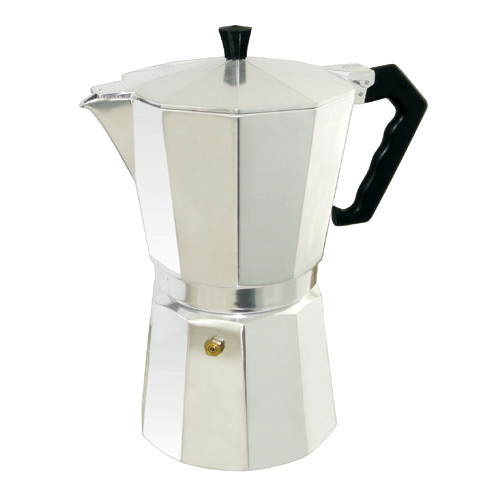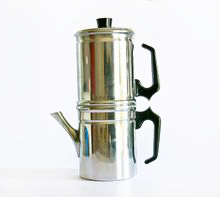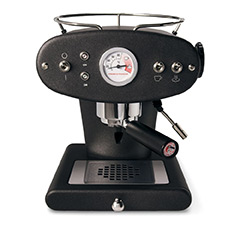How to Make Perfect Espresso at Home
How to pull the perfect shot of espresso at home? Preliminary operations: Make sure your espresso machine is turned on and has reached the ideal temperature before brewing any coffee (most non-commercial, home models are generally ready in 5 to 10 minutes, while commercial units take considerably longer).
Every part that will come in touch with the coffee should be pre-warmed, to insure that the espresso is served at the correct temperature. Other than the machine itself, parts that should be pre-warmed (maybe by showering them with hot water if you are in a hurry) include: portafilter, filter basket, espresso cup(s).

Inspect the filter basket and diffuser to make sure there are no residues of old grounds present. If you have to, rinse these parts with warm water and a soft brush (never use soap). Unless you allow used coffee grounds to build-up for several days, these parts should be fairly easy to keep clean.
Tip: use spring or distilled water to minimize scaling deposits inside the machine.
Grab a hold of some freshly ground, good-quality espresso coffee. Ideally, you would grind the quantity needed with a burr grinder. If you are using pre-ground coffee, check the grind (it should be very fine, almost powder-like, and stain your fingers) and smell it. Does it taste fresh? OK, let’s go on.
Brewing operations: Each 1.5 to 2 oz/cup of espresso requires 6.5 to 7.5 grams (approx 0.2 to 0.25 oz) of ground coffee. The easiest way to measure the ground coffee would be to use a scoop designed for this purpose. Most espresso machines include one of these spoons in the box: 1 level spoon per cup of espresso.
If you will be making a single cup, you will need the 1-cup filter basket. All espresso machines include both 1-cup and 2-cup filter baskets (if your machine claims it can brew more than 2 cups of espresso at a time, you bought a “look-alike” espresso machine, probably a cheap steam-powered unit rather than a pump-driven system. We suggest you keep away from such machines, it is almost impossible to obtain a good espresso on a consistent basis with a steam machine).
Fill the (warm) basket with the ground coffee from the measuring spoon (1 or 2, depending on the filter you will be using). Tamp the coffee in the filter using a plastic tamper (if your machine or burr grinder did not come with one, they are available at most coffee shops). The fineness of the frind and force applied when tamping will determine how the coffee comes out of the spout. So, you may need to experiment a while before you get it right.
Securely tighten the portafilter to the body of the machine, and start brewing. A good cup of espresso should take about 25 to 30 seconds to pour 1.5 to 2 oz. If it takes longer (e.g. if the coffee comes out of the spout too slow), try again with a coarser grind or with a lighter tamp. Viceversa, if the coffee comes out of the spouts too fast, try a finer grind and/or a harder tamp. Ideally, the espresso should pour with a chocolate-like consistency and color, and should produce a velvety, brown froth (“crema”) on top. The color and consistency of the crema are telling signs of a good espresso.
Ways italians prepare their coffee at home:
 “Moka” |
Moka (a.k.a. Stovetop): A three-section stovetop pot. The bottom section is filled with water, but when the water boils, it expels the air above it through a valve. The resulting vacuum forces the hot water up through the middle-mounted filter holding the coffee, and then through a tube into the top section, from which the coffee is poured. By far the method of choice of most Italian families, the “Moka” pot makes a very aromatic and full-bodied coffee, not quite as strong and concentrated as a “real” espresso, but extremely satisfying nonetheless. |
 Napoletana |
Napoletana: Also a stove-top pot whose bottom section is filled with water. A filter section full of coffee goes in the middle, surmounted by an upside-down pot. When the water boils, the whole pot is flipped over to let the water filter through the coffee. The resulting brew is generally quite mild, although the blend used (typically a very dark roast in true “Neapolitan” traditions, ground quite fine) yields a coffee that has definitely more robust flavor than a filter/drip method. |
 Espresso Machine |
Home Espresso Machine: Models for the home are available in all price ranges. The better ones duplicate the brewing system of modern, professional espresso machines, using an electric pump to force highly pressurized water (9 atm.) very quickly through a heat exchanger or (more commonly) a heating element, then through the finely ground coffee and into the cup. A separate steam nozzle is used to froth milk for cappuccino. The addition of a small burr-type grinder (again, a home version of professional grinder-dispensers) is highly desirable in such a setup to allow maximum control over the grind, which needs to be periodically adjusted according to type of blend used, atmospheric conditions, age of the blend, etc. |
Buying and Storing Espresso Coffee
Large bags or cans of preground coffee don’t make much sense for home coffee lover, and yet many people, attracted by the lower price of these packs at local supermarkets, opt for this solution. What may seem like a good deal in the store, turns out later to be an unsatisfying experience at home, since coffee (especially when preground) is highly perishable and will maintain its optimal flavor and taste for just a few days at best.
Therefore, if possible, buy small quantities of freshly roasted, ground coffee at a time. Better yet ( and ideally) you would want to buy whole beans and grind just the amount needed for brewing at a particular time. To do this, however, you would also need a small, burr-type “espresso” grinder with an adjustable set of grinding blades. Cheaper grinders commonly sold at discount stores (the ones with a spinning blade at the bottom of the grinding chamber) are not very good to grind any type of coffee, and particularly espresso. They are unable to achieve the level of uniform grind required by espresso machines for proper extraction, and their motors tend to heat up quite quickly, in effect “overroasting” the coffee as you grind it.
Espresso Roasts
A note about espresso roasts: they tend to be darker than regular roasts. However, the perception in countries outside of Italy seems to be that, the darker the roast, the better the espresso is going to taste. This is absolutely false. A lot depends on the quality of the blend. Different varietals (coffees from various countries of origin) require different degrees of roasting. In Northern Italy, espresso roasts tend to be much lighter than in the South, and they make higher usage of Arabica coffee. In the South, they use a higher percentage of Robustas (coffees with higher content of caffeine) to make their blends stronger. Strength is not to be confused with bitterness, which is typical of poor-quality, overroasted, or poorly packaged coffees. If a bean seems too oily and black,rather than dark brown, chances are it will taste bitter and sour, regardless of the method used to brew it. Italian roasters have a lot more experience (and technology) with espresso blends than newcomers from abroad, and they generally offer products of higher and more consistent quality.
Whether you opt to buy beans or preground, buy freshly roasted coffee. Local roasters make all sorts of claims about the freshness of their coffees, and in most cases they are right. However, freshly roasted beans packed in non-vacuum-packed containers stay fresh for just a handful of days. Therefore, be suspicious of mail-ordered coffee that arrives in paper, plastic, or any other packaging that does not look hermetically sealed . The best guarantee of freshness, short of living next to a roasting plant, is to buy vacuum-packed coffee. Vacuum packing will not stop the aging process of the coffee, but will slow it down to a crawl. This method can preserve coffee in its ideal conditions for up to 1 – 1 ½ year, as long as the process is conducted immediately after roasting. The most prestigious coffee roasters around the World use either nitrogen-flushed cans or bags equipped with one-way valves to vacuum-pack their coffees. Freshly roasted coffee should smell as such when you open the bag. Trust your own judgement, not the marketing hyperboles of the manufacturer.
Once open though, even the freshest coffee will quickly age. Once again, buy the least amount you can, and store the product in an airtight container when not in use (glass jars work well, as do cans with plastic lid that coffee is sometimes packed into). Whole beans will be OK for 10 to 15 days if you store them in a cool place, away from light and moisture. Preground may last 3 to 7 days max under the same conditions, as more of the surface comes into contact with air. If you are sure the container you are using is completely airtight, you can safely store it in the refrigerator to slow the aging process further. Whole beans can also go in the freezer, but if you need to freeze your coffee, you are probably buying too much to begin with.
